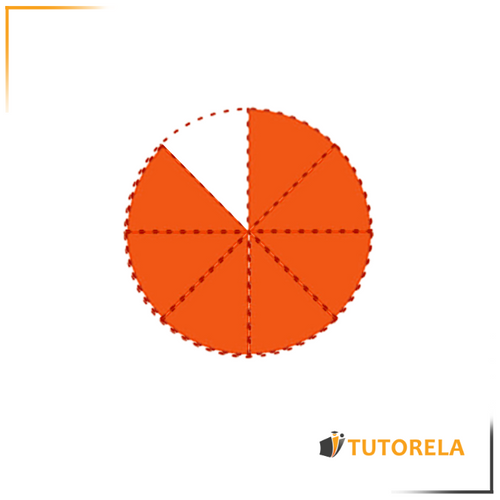What is the numerator? The numerator is the top number of a fraction and represents the portion within the whole part.
Numerator
Test yourself on simple fractions!
Write the fraction shown in the diagram as a number:
Numerator
In this article, you will learn everything you need to know about the numerator and its function in fractions.
What is the numerator?
The numerator is one of the components of the fraction, therefore, to better understand what the numerator is, let's first talk about fractions.
A fraction is a number that is composed of two numbers:
The top one which is called the numerator
A fraction bar that represents division
And the bottom number which we call denominator
For example:

The fraction could represent a certain part or even the entirety of a whole number.
Write the fraction shown in the diagram as a number:
Write the fraction shown in the drawing, in numbers:
Write the fraction shown in the drawing, in numbers:
What function does the numerator serve?
The numerator represents a certain part within the whole.
For example, in the fraction
,
The numerator 5 represents 5 eighths –> portions or parts within .
Explanatory note as a gift: The in the denominator represents the whole –>
parts or portions
Let's see it illustrated:

Now that you know everything you need about the numerator, let's practice!
Discover the fractions with numerator :
Solution:
In this fraction, the numerator is –> the number located at the top.
In this fraction, the numerator is –> the number located at the top.
Write fractions that have the number in the numerator
Solution:
In the three fractions we wrote, the numerator is . Any fraction you write with in the numerator and with any whole number except in the denominator, will be a correct answer.
Examples and exercises with solutions of Numerator
Exercise #1
Write the fraction shown in the diagram as a number:
Video Solution
Step-by-Step Solution
The number of parts in the circle represents the denominator of the fraction, while the number of coloured parts represents the numerator.
The circle is divided into 2 parts and 1 part is coloured.
If we rewrite this as a fraction, we obtain the following:
Answer
Exercise #2
Write the fraction shown in the diagram as a number:
Video Solution
Step-by-Step Solution
The number of parts in the circle represents the denominator of the fraction, while the number of coloured parts represents the numerator.
The circle is divided into 3 parts and 2 parts are coloured.
Hence:
Answer
Exercise #3
Write the fraction shown in the drawing, in numbers:
Video Solution
Step-by-Step Solution
The number of parts in the circle represents the denominator of the fraction, and the number of colored parts represents the numerator.
The circle is divided into 3 parts, 1 part is colored.
Hence:
Answer
Exercise #4
Write the fraction shown in the drawing, in numbers:
Video Solution
Step-by-Step Solution
The number of parts in the circle represents the denominator of the fraction, and the number of colored parts represents the numerator.
The circle is divided into 3 parts, 3 parts are colored.
Hence:
Answer
Exercise #5
Write the fraction shown in the drawing, in numbers:
Video Solution
Step-by-Step Solution
The number of parts in the circle represents the denominator of the fraction, and the number of colored parts represents the numerator.
The circle is divided into 4 parts, 2 parts are colored.
Hence:
Answer
Write the fraction shown in the drawing, in numbers:
Write the fraction shown in the drawing, in numbers:
Write the fraction shown in the drawing, in numbers:
More Questions
Part of an Amount
- Grid Fraction Problem: Find the Ratio of Shaded Squares to Total Area
- Grid Fraction Analysis: Identifying the 4/7 Shaded Region
- Find the Fraction: Identifying the Shaded Region in a 3x4 Grid
- Calculate the Shaded Region: Rectangle Grid Proportion Problem
- Grid Fraction Problem: Identifying the 3/7 Shaded Region
Simple Fractions
Fractions as Divisors
- Compare Quotient to 1: Analyzing 1÷2 Without Calculation
- Calculate 3/5 of 15: A Fraction Distribution Problem
- Fraction Distribution Problem: Calculate Remaining Strawberry Cakes from 45 Total
- Calculate One-Third of 45: Daily Chocolate Cake Production Problem
- Solve for Red Flowers: Finding 8/9 of 36 in a Garden Problem
- The Order of Basic Operations: Addition, Subtraction, and Multiplication
- Order of Operations: Exponents
- Order of Operations: Roots
- Division and Fraction Bars (Vinculum)
- The Numbers 0 and 1 in Operations
- Neutral Element (Identity Element)
- Order of Operations with Parentheses
- Order or Hierarchy of Operations with Fractions
- Opposite numbers
- Elimination of Parentheses in Real Numbers
- Addition and Subtraction of Real Numbers
- Multiplication and Division of Real Numbers
- Multiplicative Inverse
- Integer powering
- Positive and negative numbers and zero
- Real line or Numerical line
- Fractions
- A fraction as a divisor
- How do you simplify fractions?
- Simplification and Expansion of Simple Fractions
- Common denominator
- Hundredths and Thousandths
- Part of a quantity
- Sum of Fractions
- Subtraction of Fractions
- Multiplication of Fractions
- Division of Fractions
- Comparing Fractions
- Placing Fractions on the Number Line
- Numerator
- Denominator
- Decimal Fractions
- What is a Decimal Number?
- Reducing and Expanding Decimal Numbers
- Addition and Subtraction of Decimal Numbers
- Comparison of Decimal Numbers
- Converting Decimals to Fractions
- Remainder of a fraction
- Decimal fraction remainder
- Remainders
- Order of Operations - Exponents and Roots
- Special cases (0 and 1, reciprocals, fraction line)










